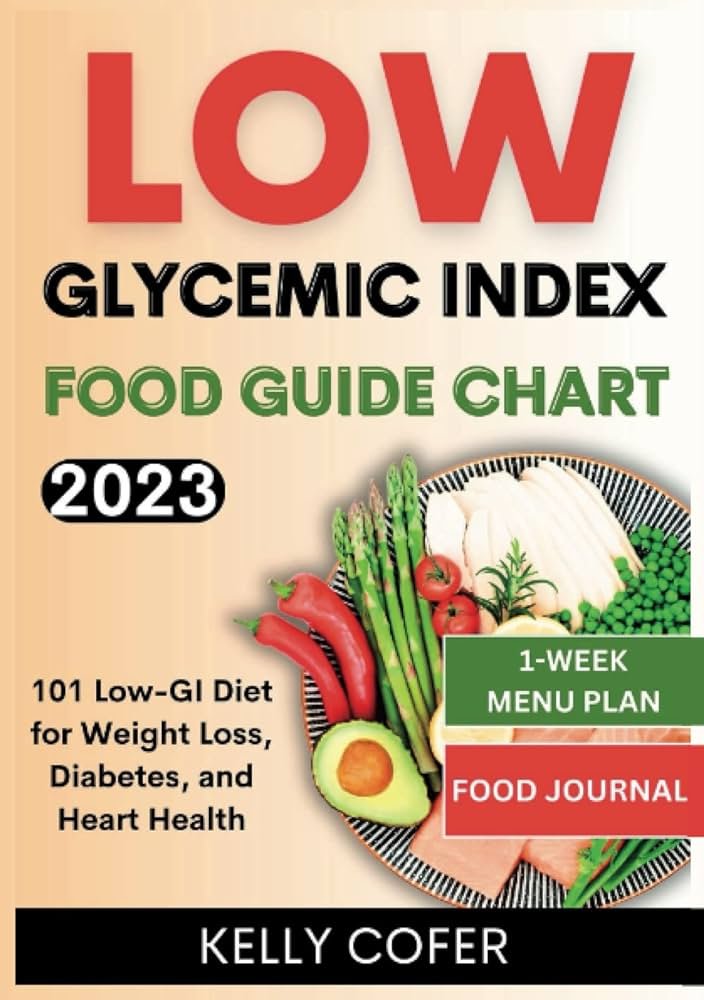Are you looking for a sustainable and effective way to lose weight? Look no further than the ultimate guide to a Low GI Diet. This comprehensive 12-week weight loss plan is designed to help you make healthier food choices and maintain stable blood sugar levels, resulting in steady weight loss. With an emphasis on long-term lifestyle changes rather than quick fixes, this guide provides you with valuable information on the Glycemic Index (GI) and offers practical tips and delicious recipes to support your weight loss journey. Say goodbye to crash diets and hello to a healthier, happier you with the Low GI Diet!
Understanding the Low GI Diet
If you’re looking for a sustainable and effective approach to weight loss and overall health, the Low Glycemic Index (GI) diet may be just what you need. By understanding how the GI affects blood sugar levels and the benefits of a low GI diet, you can implement this approach into your lifestyle with ease. In this comprehensive article, we will dig deeper into the concept of the GI, explore the implementation of a low GI diet, discuss the significance of glycemic load, highlight the numerous benefits, explore the relationship between the low GI diet and exercise, share tips and tricks for success, provide a sample low GI meal plan, answer frequently asked questions, and help you stay consistent with a low GI lifestyle.

This image is property of Amazon.com.
What is the GI?
The Glycemic Index (GI) is a ranking system that measures how quickly carbohydrate-rich foods raise your blood sugar levels compared to pure glucose, which has a GI value of 100. Foods with a high GI value (70 or above) are rapidly digested and cause a quick spike in blood sugar levels, while foods with a low GI value (55 or below) are digested more slowly, leading to a gradual increase in blood sugar levels. Understanding the GI is essential for managing blood sugar levels, promoting weight loss, and maintaining overall health.
How does the GI affect blood sugar levels?
When you consume high GI foods, such as white bread or sugary snacks, your blood sugar levels skyrocket. In response, the body releases a surge of insulin to help process the sudden influx of sugar. This rapid rise and fall in blood sugar can lead to energy crashes, increased hunger, and a higher risk of developing chronic diseases like diabetes and heart disease. On the other hand, low GI foods, like whole grains and vegetables, provide a slow release of sugar into the bloodstream, keeping you fuller for longer and providing a consistent source of energy.

This image is property of Amazon.com.
Benefits of a Low GI Diet
Adopting a low GI diet offers a multitude of benefits for both your physical and mental well-being. By incorporating more low GI foods into your meals, you can achieve weight loss and management, control your blood sugar levels, improve your energy levels, reduce the risk of chronic diseases, and support better digestive health. These benefits make the low GI diet an attractive option for individuals seeking a sustainable and balanced approach to food.
Comparing High GI and Low GI Foods
To better understand the low GI diet, it’s important to compare high GI and low GI foods. High GI foods include white bread, potatoes, and sugary drinks, while low GI foods include whole grains, legumes, and most fruits and vegetables. By swapping out high GI foods for low GI alternatives, you can optimize your diet and improve your overall health and well-being.

This image is property of Amazon.com.
Implementing a Low GI Diet
Now that you have a better understanding of the GI and its impact on blood sugar levels, it’s time to dive into implementing a low GI diet. In this section, we will explore setting goals and creating a plan, selecting the right low GI foods, meal planning and preparation, discovering healthy snack ideas, and navigating eating out while following a low GI diet.
Setting Goals and Creating a Plan
Start by setting achievable goals that align with your desired outcomes. Whether it’s losing weight, managing blood sugar levels, or improving your overall health, having a clear plan and measurable goals will keep you motivated along the way. Consider consulting a healthcare professional or registered dietitian to guide you in creating a personalized low GI diet plan that suits your needs and preferences.
Choosing the Right Low GI Foods
Selecting the right low GI foods plays a vital role in the success of your low GI diet. Incorporate a variety of nutrient-dense options such as whole grains, lean proteins, healthy fats, and fiber-rich fruits and vegetables. Aim for natural, unprocessed foods and limit your intake of refined carbohydrates and added sugars.
Meal Planning and Preparation
Meal planning and preparation are key to staying on track with your low GI diet. Set aside time each week to plan your meals and create a shopping list. By having nutritious, low GI meals readily available, you’ll be less likely to reach for high GI alternatives when hunger strikes. Consider batch cooking and portioning your meals to save time and ensure you have healthy options at hand throughout the week.
Healthy Snack Ideas
Snacking can often derail even the most well-intentioned healthy eating plans. However, with the right strategies, you can enjoy delicious and satisfying low GI snacks. Opt for snacks that combine protein, healthy fats, and low GI carbohydrates, such as Greek yogurt with berries, a handful of nuts, or carrot sticks with hummus. These options will keep you full between meals and provide a steady source of energy.
Eating Out on a Low GI Diet
Eating out while following a low GI diet doesn’t have to be challenging. It’s all about making wise choices and being mindful of portion sizes. Look for restaurants that offer low GI options on their menus, such as whole-grain dishes, lean protein sources, and plenty of vegetables. If the menu doesn’t offer low GI choices, focus on portion control and opt for grilled or steamed options rather than fried or heavily processed foods. Don’t be afraid to make special requests or ask for modifications to suit your dietary needs.
Understanding Glycemic Load
While the GI is an important concept, it does not tell the whole story. This is where the notion of Glycemic Load (GL) comes into play. In this section, we will unravel the meaning of Glycemic Load, differentiate it from the GI, explore how to calculate it, and discuss its significance in meal planning.
What is Glycemic Load?
Glycemic Load (GL) combines the impact of the GI and the actual content of carbohydrates in a food. It helps provide a more accurate picture of how a particular food affects blood sugar levels. While the GI ranks foods based on the quality of carbohydrates, the GL considers both quality and quantity.
How does Glycemic Load differ from GI?
While the GI ranks foods solely based on their impact on blood sugar levels, the GL takes into account the actual serving size and carbohydrate content of a food. For example, watermelon has a high GI but a low GL because it contains a relatively small amount of carbohydrates. Understanding the difference between the GI and GL allows you to make more informed decisions when planning your meals and optimizing your blood sugar levels.
Calculating Glycemic Load
Calculating the Glycemic Load of a food is relatively simple. Multiply the food’s GI value by the amount of carbohydrates it contains per serving and divide by 100. This equation provides a more accurate measure of the food’s impact on blood sugar levels. By focusing on low GL foods, you can ensure a more controlled release of sugar into your bloodstream.
Using Glycemic Load in Meal Planning
By incorporating both the GI and GL into your meal planning, you can create a balanced and nutritious diet that promotes stable blood sugar levels. Aim for meals that consist of mostly low GI and low GL foods. Combine whole grains, lean proteins, healthy fats, and a variety of fruits and vegetables to create a well-rounded plate. Balancing your carbohydrate intake with other macronutrients helps slow down the absorption of sugar into your bloodstream, preventing blood sugar spikes and crashes.

This image is property of Amazon.com.
Benefits of a Low GI Diet
The low GI diet offers an array of benefits that extend beyond just weight loss. By adopting this approach, you can experience weight management, blood sugar control, improved energy levels, reduced risk of chronic diseases, and better digestive health. Let’s explore these benefits in more detail:
Weight Loss and Management
The low GI diet can be particularly beneficial for weight loss and management. Low GI foods tend to be more filling, keeping you satisfied for longer periods and reducing the likelihood of overeating. Additionally, their slow digestion and release of sugar help control insulin levels, preventing spikes and crashes, which can contribute to weight gain.
Blood Sugar Control
For individuals with diabetes or prediabetes, maintaining stable blood sugar levels is crucial. The low GI diet can help achieve this by choosing foods that have a gentler impact on blood sugar levels. By avoiding high GI foods that cause rapid blood sugar spikes, you can better manage your glucose levels and potentially reduce the need for medication.
Improved Energy Levels
The steady release of sugar from low GI foods provides a consistent and sustained source of energy throughout the day. Unlike high GI foods that provide a quick energy burst followed by a crash, low GI foods provide a more stable energy supply, helping you feel more alert and focused for an extended period.
Reduced Risk of Chronic Diseases
Adopting a low GI diet has been associated with a reduced risk of chronic diseases such as type 2 diabetes, heart disease, and certain types of cancer. By incorporating more whole grains, fruits, vegetables, and lean proteins into your meals, you provide your body with essential nutrients while minimizing the risk factors linked to these diseases.
Better Digestive Health
A diet high in fiber, such as the low GI diet, supports better digestive health. Fiber helps regulate bowel movements, prevents constipation, and promotes a healthy gut microbiome. By including fruits, vegetables, whole grains, and legumes in your diet, you can support your digestive system and prevent digestive issues.
Low GI Diet and Exercise
Exercise is a crucial component of a healthy lifestyle, and when combined with a low GI diet, its benefits are amplified. In this section, we will discuss the role of exercise in weight loss, choosing the right exercise for you, timing your workouts with low GI meals, and fueling your body with the right pre- and post-workout nutrition.
The Role of Exercise in Weight Loss
Exercise is essential for weight loss as it helps burn calories and build muscle mass. When you combine exercise with a low GI diet, you create a powerful synergy that maximizes your body’s ability to shed unwanted pounds. Regular physical activity also contributes to improved cardiovascular health, increased metabolism, and enhanced overall well-being.
Choosing the Right Exercise
When it comes to choosing the right exercise, it’s crucial to consider your preferences, fitness level, and any underlying health conditions. Opt for activities that you enjoy and that align with your goals. Whether it’s cardiovascular exercises like running or cycling, strength training using weights or resistance bands, or mind-body exercises like yoga or Pilates, find a routine that keeps you motivated and engaged.
Timing Exercise with Low GI Meals
Timing your workouts with low GI meals can optimize your performance and recovery. By consuming low GI carbohydrates about an hour before your workout, you provide your body with a steady source of energy. Additionally, post-workout, replenishing your glycogen stores with low GI carbohydrates and combining them with protein can aid in muscle recovery and glycogen synthesis.
Pre- and Post-Workout Nutrition
To fuel your body for exercise, consider pre-workout snacks that are low GI and easy to digest. Opt for options like a small portion of Greek yogurt with berries, a banana with almond butter, or a handful of nuts and seeds. After your workout, aim for a balanced meal or snack that includes low GI carbohydrates and lean protein. This combination helps repair and build muscle while replenishing energy stores.

This image is property of Amazon.com.
Overcoming Challenges on a Low GI Diet
Adopting a low GI diet comes with its own set of challenges. However, with the right strategies, you can overcome these obstacles and stay on track. In this section, we will discuss strategies for dealing with cravings and hunger, navigating social situations, managing dining out, resisting high GI temptations, and staying motivated throughout your journey.
Dealing with Cravings and Hunger
Cravings and hunger pangs can derail even the most dedicated individuals on a low GI diet. To combat cravings, be sure to include a variety of flavors, textures, and colors in your meals. This helps satisfy your taste buds and keeps you feeling satisfied. Additionally, staying hydrated, eating regular meals and snacks, and choosing fiber-rich foods can help curb cravings and minimize feelings of hunger.
Navigating Social Situations
Social situations can often be challenging when you’re following a specific eating plan. However, navigating these situations is possible with a few strategies. Communicate your dietary needs and goals to friends and family so they can support and accommodate your choices. Offer to bring a low GI dish to gatherings, or eat a balanced meal before attending an event, so you’re not solely relying on the available options. Remember, it’s important to enjoy social occasions while still prioritizing your health.
Managing Dining Out
Dining out can pose challenges when trying to adhere to a low GI diet. However, with a little planning, you can make healthier choices. Review menus in advance and choose restaurants that offer low GI options. Look for dishes that include whole grains, lean proteins, and a good portion of vegetables. If the options are limited, focus on portion control and avoid fried or heavily processed foods. Don’t be afraid to ask for modifications to suit your dietary needs.
Resisting High GI Temptations
High GI temptations are inevitable, but you have the power to resist them. By understanding the potentially detrimental effects of high GI foods on your blood sugar levels and overall health, you can make informed choices. Opt for low GI alternatives when cravings strike, such as choosing berries over sugary desserts or whole grain bread over white bread. Remember that small indulgences occasionally can be part of a balanced lifestyle, but maintaining consistency with your low GI diet should be your priority.
Staying Motivated
Staying motivated on a low GI diet is essential for long-term success. Find a source of motivation that resonates with you, whether it’s improved health, increased energy levels, or fitting into your favorite clothes. Celebrate your achievements along the way and reward yourself with non-food-related treats when you reach milestones. Surround yourself with a supportive network of friends, family, or fellow low GI dieters who can provide encouragement and accountability.
Tips and Tricks for Success
To ensure success with your low GI diet, consider implementing these tips and tricks into your daily routine:
Reading Food Labels
Reading food labels becomes a habit when following a low GI diet. Pay attention to the total carbohydrate content, fiber content, and ingredients. Look for foods that are minimally processed, high in fiber, and do not contain added sugars or artificial additives.
Cooking and Food Preparation Tips
Cooking and preparing your meals at home gives you full control over the ingredients and cooking methods used. Opt for cooking techniques like grilling, steaming, baking, or sautéing instead of deep frying. Experiment with herbs, spices, and natural flavor enhancers to add excitement to your meals without relying on high GI ingredients.
Stocking a Low GI Pantry
Stocking your pantry with low GI staples helps create a foundation for nutritious meals. Keep items such as whole grains (brown rice, quinoa), legumes (lentils, chickpeas), nuts and seeds, extra virgin olive oil, and a variety of herbs and spices on hand. This ensures you have a range of low GI options available to you at any given time.
Making Healthy Substitutions
Making healthy substitutions is a key strategy in a low GI diet. Swap high GI foods for their low GI counterparts whenever possible. For instance, choose sweet potatoes instead of white potatoes, whole wheat pasta in place of regular pasta, and unsweetened Greek yogurt instead of sugary flavored yogurt. These small changes can have a significant impact on your blood sugar levels and overall health.
Combining Low GI Foods
Combining low GI foods in your meals helps create well-balanced and satisfying dishes. Ensure each meal contains a source of lean protein, healthy fats, and low GI carbohydrates. For example, pair grilled chicken breast with steamed broccoli and quinoa or enjoy a mixed green salad topped with salmon and a sprinkle of nuts and seeds. These combinations provide a range of nutrients and support stable blood sugar levels.
Sample Low GI Meal Plan
To help you get started with your low GI diet, we’ve prepared a sample meal plan that showcases a variety of low GI foods. Remember to adapt it to your preferences and dietary needs:
Breakfast Ideas
- Avocado toast on whole grain bread with a side of scrambled eggs and spinach.
- Overnight oats made with rolled oats, almond milk, and berries.
- Veggie omelet with mushrooms, peppers, and onions served with a slice of whole grain toast.
Lunch Options
- Mixed green salad with grilled chicken breast, cherry tomatoes, cucumber, and balsamic vinaigrette.
- Lentil soup with a side of mixed greens and whole grain crackers.
- Quinoa salad with roasted vegetables, feta cheese, and a drizzle of olive oil.
Dinner Recipes
- Baked salmon with roasted sweet potatoes and steamed asparagus.
- Grilled chicken with a side of quinoa and sautéed green beans.
- Turkey chili with kidney beans, served with a side salad.
Snacks and Desserts
- Greek yogurt with a sprinkle of nuts and berries.
- Carrot sticks with hummus.
- Apple slices with almond butter.
FAQs about the Low GI Diet
As you embark on your low GI diet journey, you may have questions about its suitability, impact on diabetes management, timeframe for results, potential side effects, and whether carbohydrates are still allowed. Let’s address these frequently asked questions:
Is the Low GI Diet suitable for everyone?
The low GI diet is generally suitable for most individuals, including those without specific dietary restrictions. However, it’s always best to consult with a healthcare professional or registered dietitian before starting any new diet plan, especially if you have specific health concerns.
Can the Low GI Diet help with diabetes management?
Yes, the low GI diet can be beneficial for individuals with diabetes or prediabetes. By choosing low GI foods that have a minimal impact on blood sugar levels, individuals can better manage their glucose levels and potentially reduce their reliance on medication. It’s important to work closely with a healthcare professional to determine the best dietary approach for your specific needs.
How quickly can I expect to see results?
The rate at which you see results will vary depending on factors such as your starting weight, adherence to the low GI diet, activity level, and individual metabolism. While some may experience noticeable changes within a few weeks, others may require a longer period of time to see significant progress. Remember, the low GI diet is a long-term approach to health and weight management, not a quick fix.
Are there any potential side effects?
The low GI diet focuses on whole, minimally processed foods, making it generally safe and well-tolerated. However, some individuals may experience temporary side effects such as increased flatulence, bloating, or changes in bowel movements as their bodies adjust to a higher intake of fiber-rich foods. These symptoms should subside as your body adapts to the new dietary pattern.
Can I still enjoy carbohydrates on a Low GI Diet?
Yes, carbohydrates are a vital part of a balanced diet, even on a low GI plan. The key is to choose carbohydrates that have a lower GI value and provide more sustained energy. Focus on incorporating whole grains, legumes, and most fruits and vegetables into your meals, and be mindful of portion sizes to maintain a balanced intake of carbohydrates.
Staying Consistent with a Low GI Lifestyle
Consistency is key to maintaining a low GI lifestyle. By tracking your progress, monitoring your GI intake, celebrating milestones, building a support system, and developing healthy eating habits for life, you can ensure the long-term success of your low GI journey.
Tracking Progress and Monitoring GI Intake
Keep track of your progress by monitoring your weight, measuring your body composition, and recording any changes in your overall well-being. Additionally, you can track your GI intake by utilizing resources such as GI databases and mobile apps that provide information on the GI values of different foods. Although not necessary for everyone, tracking can help you stay mindful of your choices and make adjustments if needed.
Celebrating Milestones
Celebrate your milestones, no matter how small they may seem. Recognize and reward yourself for your achievements, whether it’s losing a few pounds, fitting into a smaller clothing size, or successfully incorporating more low GI foods into your meals. Celebrating milestones reinforces positive behaviors and motivates you to continue on your journey.
Building a Support System
Building a support system is crucial for staying consistent with a low GI lifestyle. Surround yourself with like-minded individuals who share similar goals or join online communities and forums dedicated to the low GI diet. Having a support system not only provides encouragement and accountability but also offers valuable advice and insights.
Developing Healthy Eating Habits for Life
Adopting a low GI lifestyle isn’t just about a short-term diet plan; it’s about creating sustainable and healthy eating habits for life. Emphasize balance, moderation, and portion control in your daily meals. Continue to incorporate low GI foods into your diet while enjoying occasional higher GI treats in moderation. By cultivating healthy eating habits, you’ll be able to maintain your progress long-term.
In conclusion, understanding and implementing a low GI diet can have a significant impact on your overall health and well-being. By focusing on low GI foods, you can manage your blood sugar levels, achieve weight loss and weight management, experience improved energy levels, reduce the risk of chronic diseases, and support better digestive health. By employing the strategies, following the tips and tricks, and incorporating the sample meal plan provided, you’ll be well on your way to a successful low GI diet journey. Remember, consistency and perseverance are key, and with the right mindset and support system, you can develop healthy eating habits that last a lifetime.
